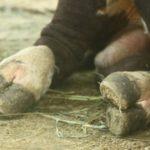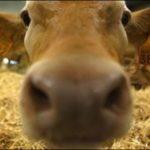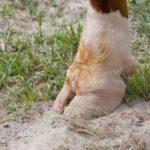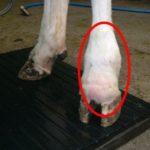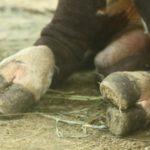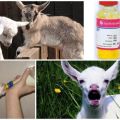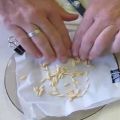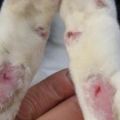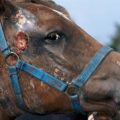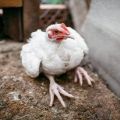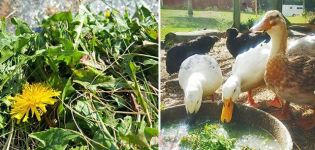Names and causes of hoof diseases in cows, symptoms and treatments
Hoof diseases in animals such as cows are successfully treated in the early stages. It is important to correctly determine the cause of the disease, eliminate unfavorable factors and immediately begin treatment. Most diseases of cattle hooves are caused by the large weight of such animals and errors in their keeping. Early treatment saves cows from lameness and painful symptoms. In advanced cases, the death of cattle is possible.
Pododermatitis
This is a disease in which, as a rule, the inner hoof becomes inflamed from the inside, that is, an inflammatory process occurs in the soft tissues under the stratum corneum. The defeat also affects the skin part, therefore it is called pododermatitis. The disease can be aseptic and purulent. However, the outer claw usually appears healthy.
The disease is caused by keeping animals on a wet and dirty litter, trauma to the sole, heavy weight of the cow, as well as different loads on the component parts of the hoof. After cleaning, reddish spots are found on the inner hoof, and in advanced cases, deep cavities.
If dirt or manure gets inside, an inflammatory process begins, a purulent exudate appears. A sick animal limps, often raises its leg, its temperature rises. The inflamed limb becomes hot, pulsation is felt when palpating.
In case of pododermatitis, first of all, they clean the hoof from dirt and wash it. The diseased hoof is anesthetized with novocaine, and the pus is opened and removed. The exfoliated tissue is cut off. The cleaned cavity is washed with an antiseptic (hydrogen peroxide, "Chlorhexidine"), treated with wound-healing agents ("Liniment synthomycin", "Antibax" ointment) and a cotton-gauze bandage is applied. A wooden block is glued to a healthy hoof. The dressing and waterproof bandages are changed every 3 days. The hoof heals within a month.

Corolla phlegmon
This is an inflammation of the subcutaneous tissue in the corolla (coronary bone). Phlegmon occurs due to injury or injury. The inflammatory process can be purulent if, as a result of a bruise, an infection penetrates through the damaged skin.
Externally, swelling is noticeable above the horny shoe. The fiber is impregnated with serous-hemorrhagic exudate. Abscesses are formed. Often there is a breakthrough of pus outward. A sick animal is limping, its temperature rises. The limb becomes sore to the touch and hot. Over time, the stratum corneum exfoliates on the hoof.
In the course of treatment, the animals are injected with an antibiotic and an anesthetic (Novocain). Apply an alcohol-based wet bandage to the affected area. It is changed every day.Purulent swelling is opened, the cavity is washed with a disinfectant (hydrogen peroxide). An antibacterial and wound-healing bandage is applied on top (Levomekol ointment, streptocidal, tetracycline). The cotton-gauze compress is changed every three days. Recovery occurs in 1-2 weeks.
Hoof erosion
This is a disease in which the outer stratum corneum of the sole is affected, and in severe cases, the soft tissue inside the hoof. The reason is a large load on the limbs, traumatic stony soil, wet and dirty litter, cracks in the hooves and penetration of the infection. Dark spots, rot and bruising are visible on the surface of the sole.
A sick animal limps, its temperature rises, the leg becomes hot and painful when touched.
During treatment, the affected areas are cleaned of dirt, washed with water, disinfected with an antiseptic (potassium permanganate solution or hydrogen peroxide). A bandage with an antibiotic solution ("Tetracycline", "Penicillin") or a wound-healing agent (tetracycline ointment, streptocide ointment, "Levomekol") is applied to the hoof, which is changed 1-2 times a day. The animal is kept indoors on a dry bed for several days.

Strawberry disease
This is a condition in which the affected areas resemble red strawberries. The correct name for the disease is digital dermatitis or Mortellaro's disease. The development of the disease is caused by bacteria found on damp floors in the barn, multiplying in dirty litter. Finger dermatitis affects even young animals. Lesions are localized in the area of the hoof slit or diadem. Reddish bumps appear on the skin.
As a prophylaxis of the disease, it is recommended to keep cows on a clean and dry bedding, to provide cattle with high-quality feed. For treatment (compresses and dressings) use powder forms of tetracycline ("Egocin"), antibiotic "Oxytetracycline". During the period of treatment, the animals are given pharmaceutical vitamin and mineral preparations.
Laminitis
This is a cattle disease in which the soft tissue under the stratum corneum becomes inflamed. The disease affects the hoof. The inflammation occurs because the blood does not reach the lamellar layer (sensitive tissues inside the hoof), but stops near the corolla. Necrosis occurs due to the cessation of blood supply. The coffin bone presses on the sole, comes out.
Subsequently, the horn shoe completely comes off, exposing soft sensitive tissues. When an infection is ingested, pus accumulates at the site of the lesion. The cause of the disease is too large an animal's weight, traumatic surfaces, rocky soil, bruises, injuries, cracks in the sole. A sick cow limps, refuses to move, and the hoof becomes sore and hot. When treating a sick animal, they provide full care, provide high-quality food, and keep it on a dry bed. The wound is cleaned, washed with an antiseptic (hydrogen peroxide).
It is recommended that the hoof be exposed to cold (ice baths, wet cold clay). You will not be able to cure laminitis on your own. It is better if you find symptoms similar in description to this disease, contact your veterinarian. The sooner treatment begins, the more likely the hoof will heal.
Lameness
Lameness is a symptom of any hoof disease. When the integrity of the sole is violated, an infection penetrates inside, and an inflammatory process begins, the animal's limb hurts and heats up.The cow limps, holds the leg up or pulls it, tries to move less.

The causes of lameness vary. Basically, problems arise if cows graze on stony soils, are often injured, are kept on wet and dirty litter, and eat poor-quality feed. If you find that the animal is limping, you need to carefully clean and inspect the hoof. Ulcers and erosion can be treated with an antiseptic (hydrogen peroxide) and an antibiotic ointment (streptocide, tetracycline).
Wounds are covered with bandages with wound-healing medicines, which are changed daily until the cows recover.
Lameness can occur not only due to problems with the hooves, but also as a result of ruptured tendons, rheumatoid arthritis, nerve palsy, arterial thrombosis. If there are no visible wounds on the hoof, then it is best to see a veterinarian and examine the animal.
Bruises
With injuries, stumbling and blows, hoof bruises occur - closed damage to internal tissues without violating the integrity of the stratum corneum. A hematoma appears at the site of the lesion. At the same time, the level of leukocytes in the blood rises, and the inflammatory process begins. As a result of the ruptured vessels, a blood clot forms. If there is a crack in the cornea, an infection gets inside. The site of the injury begins to fester. A sick cow may limp, experience pain and anxiety. The bruised limb becomes hot.
It is advisable to detect a bruise as early as possible and apply cold to the affected area or immerse the leg in an ice bath. If the injury is not fresh, then you need to open the stratum corneum and release the accumulated blood and pus from the hoof. It is recommended to treat the lesion site with an antiseptic (hydrogen peroxide, potassium permanganate solution) and an antibiotic-based ointment (Levomycetin, Antibax). It is advisable to put a cotton-gauze bandage on the hoof and wrap it with waterproof bandages.
